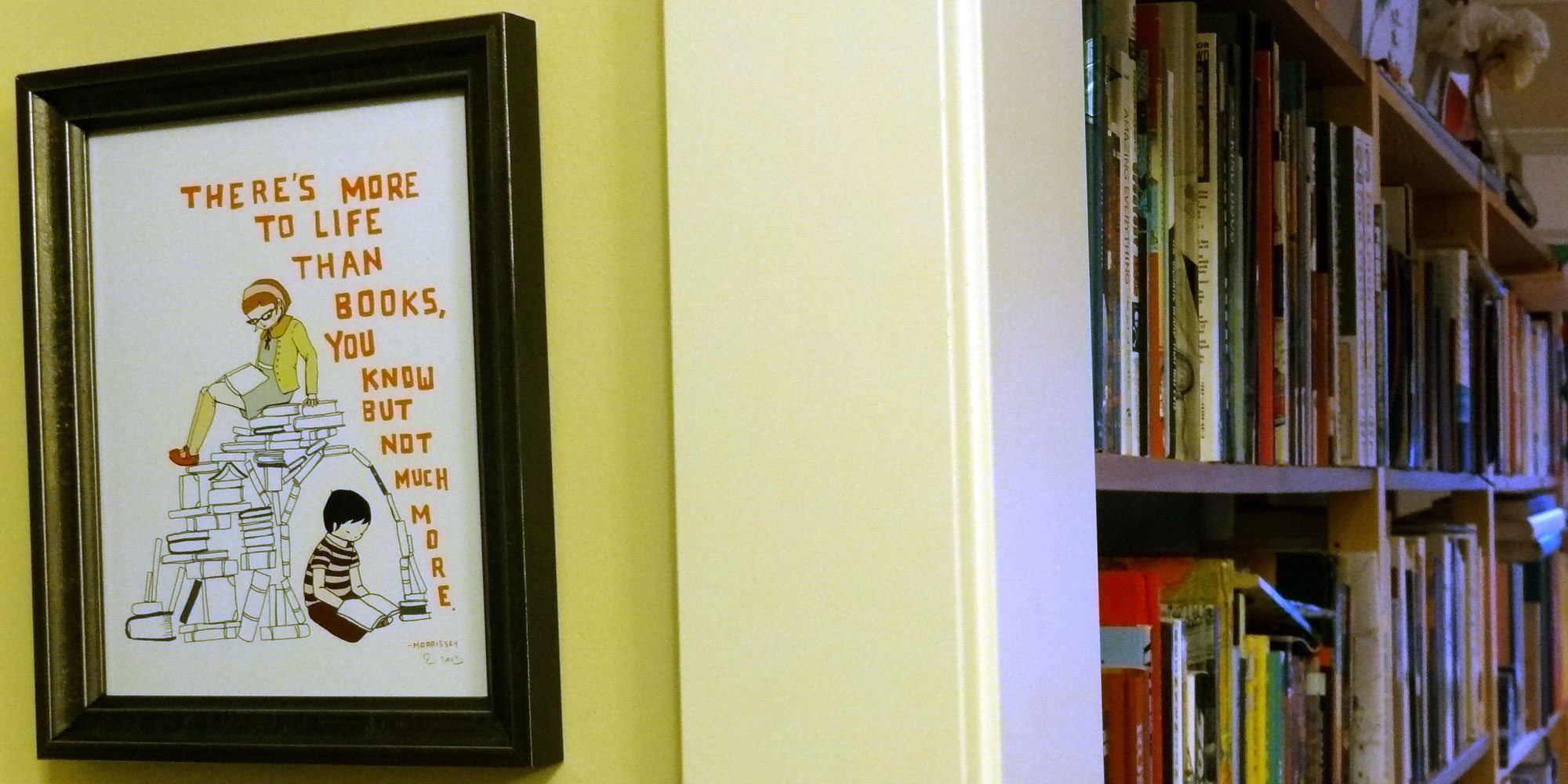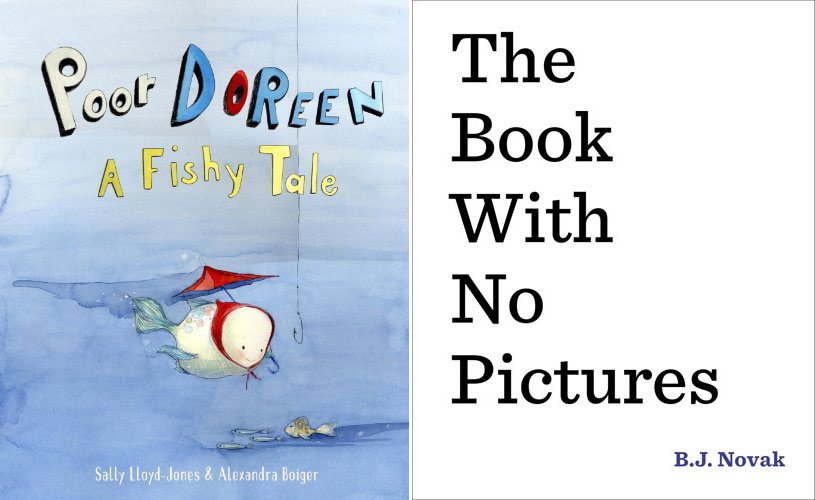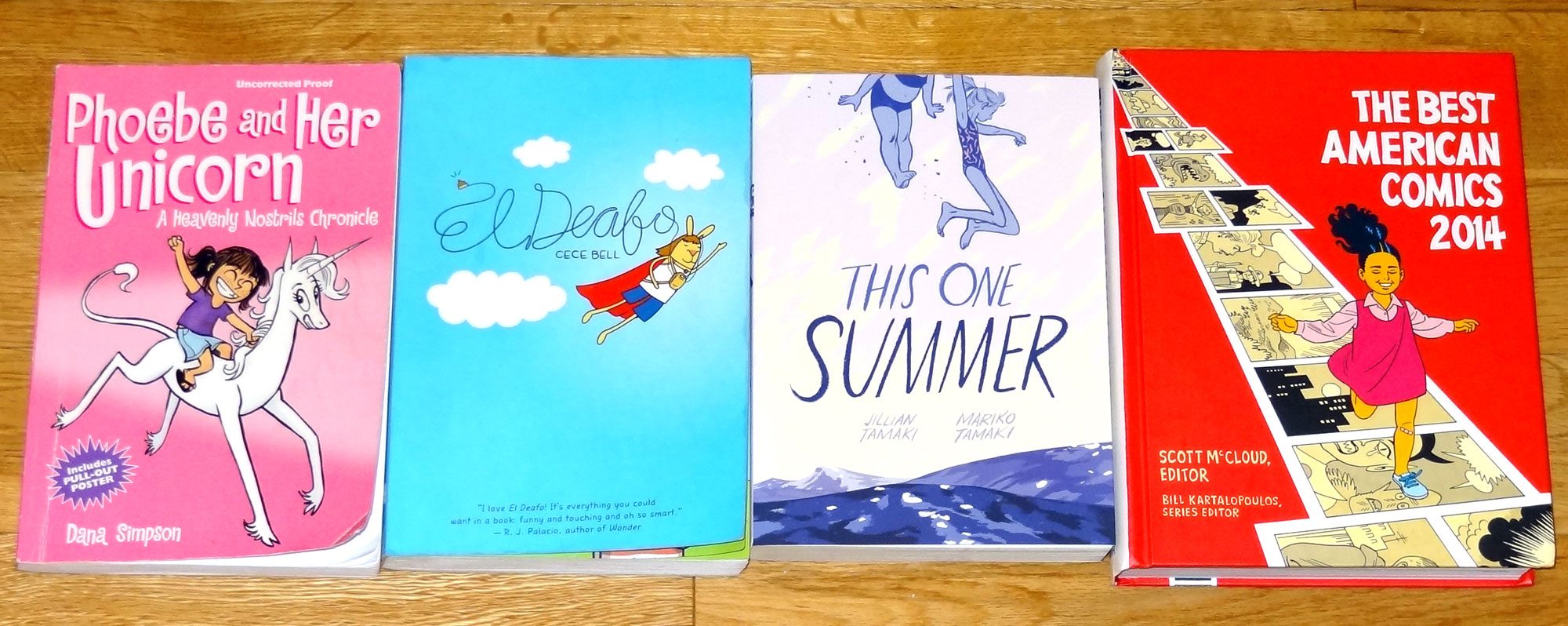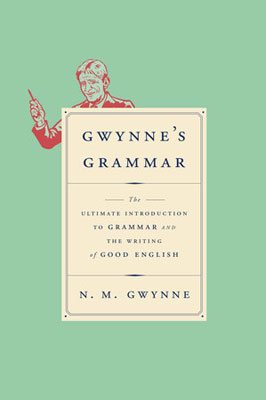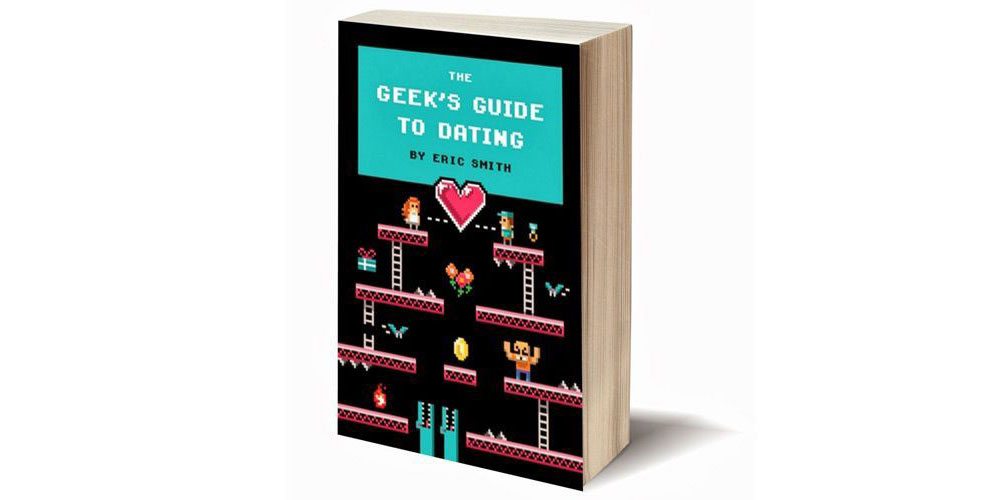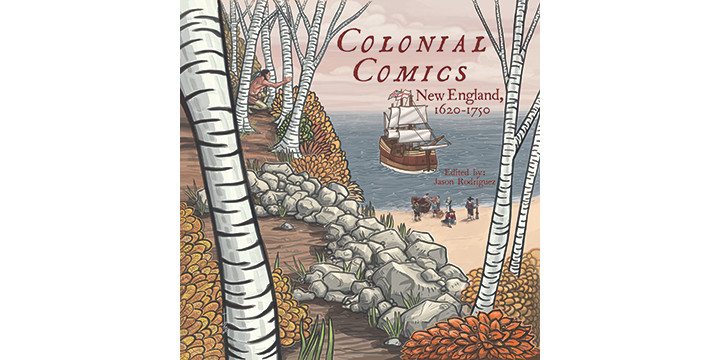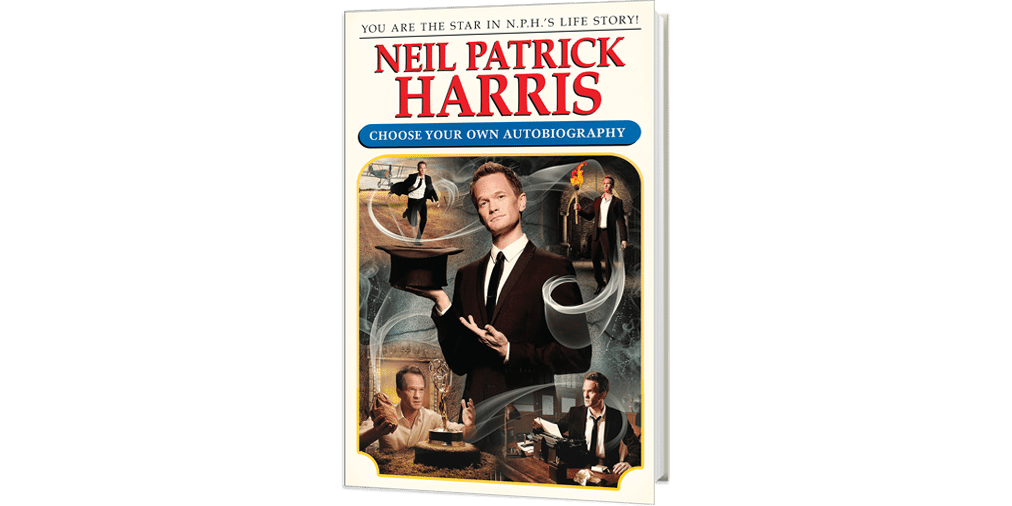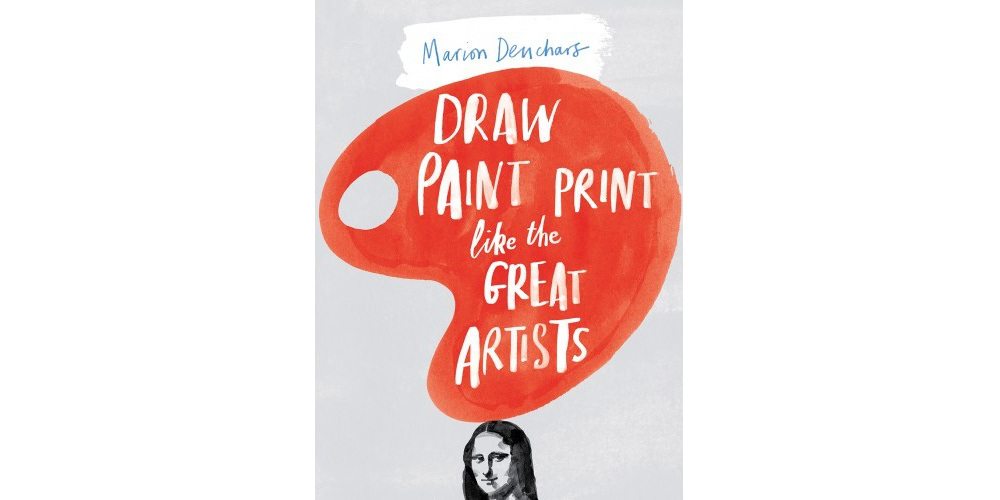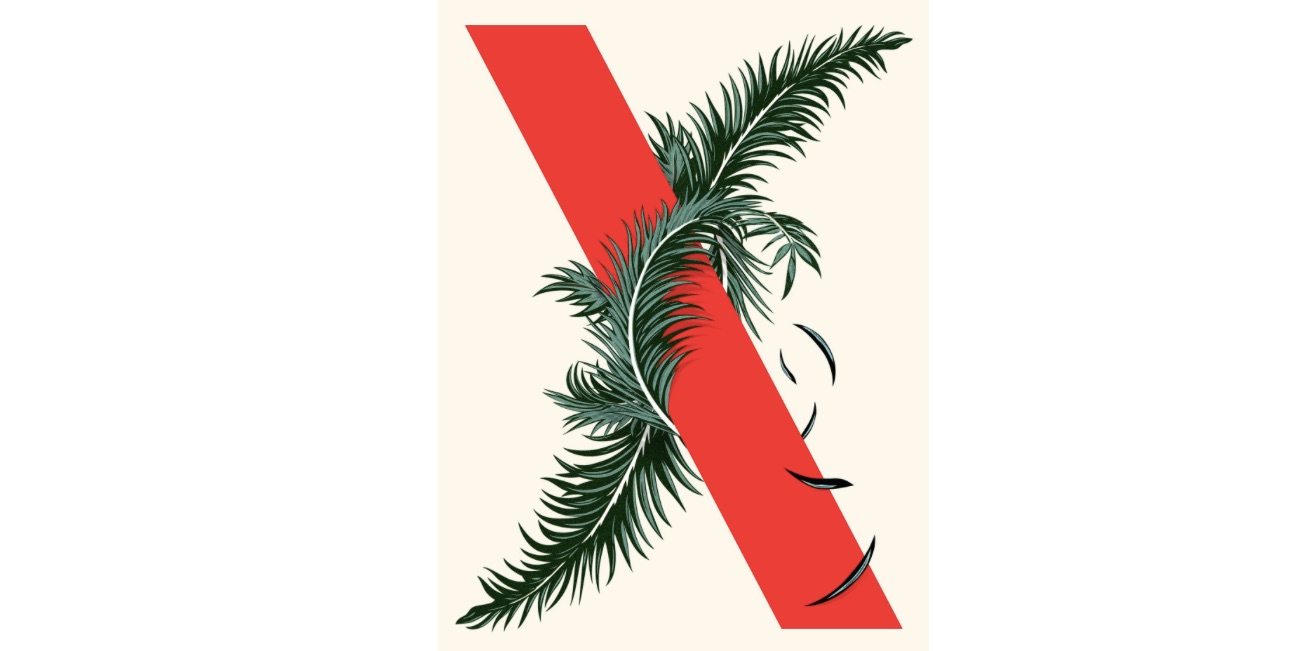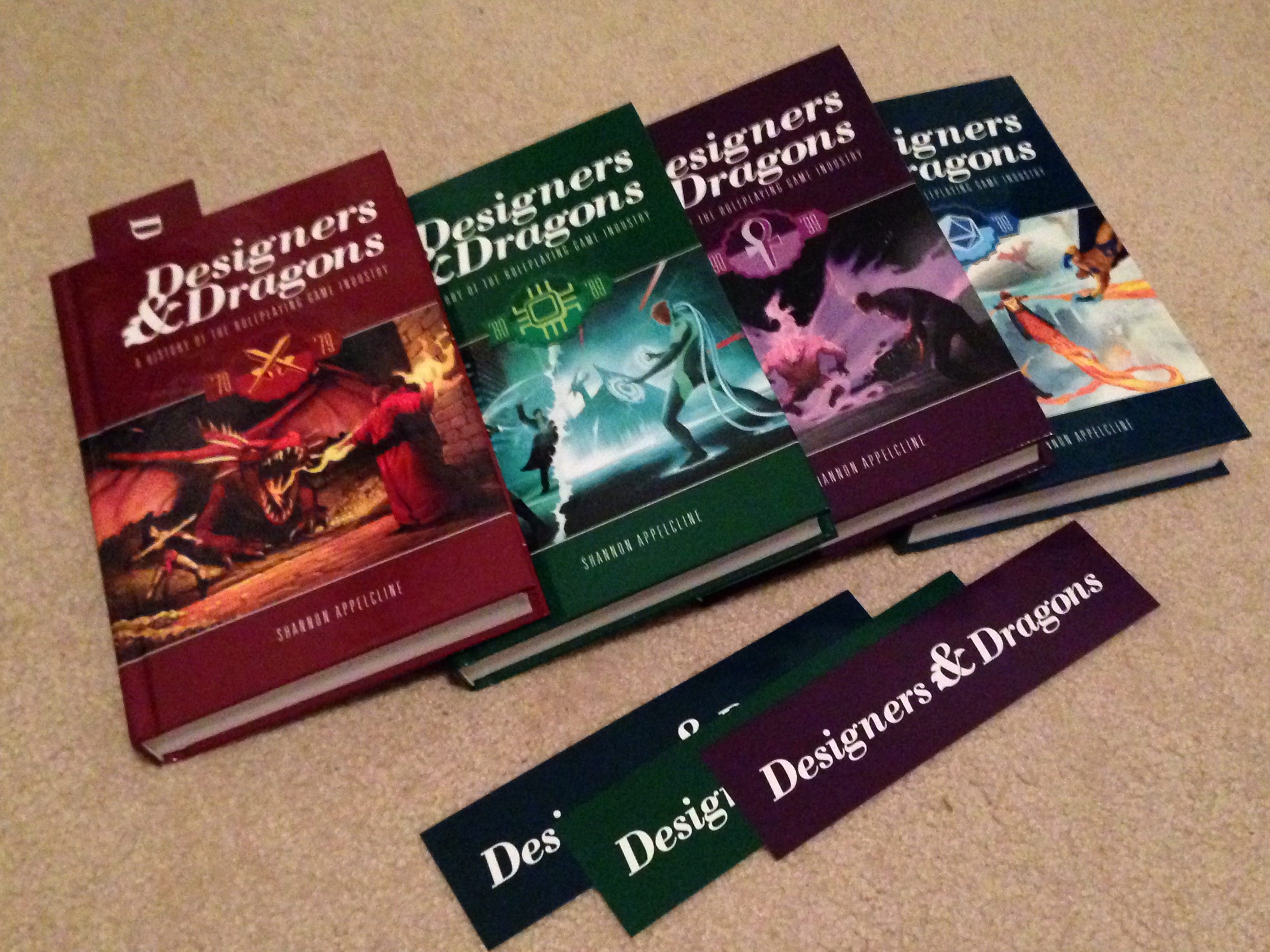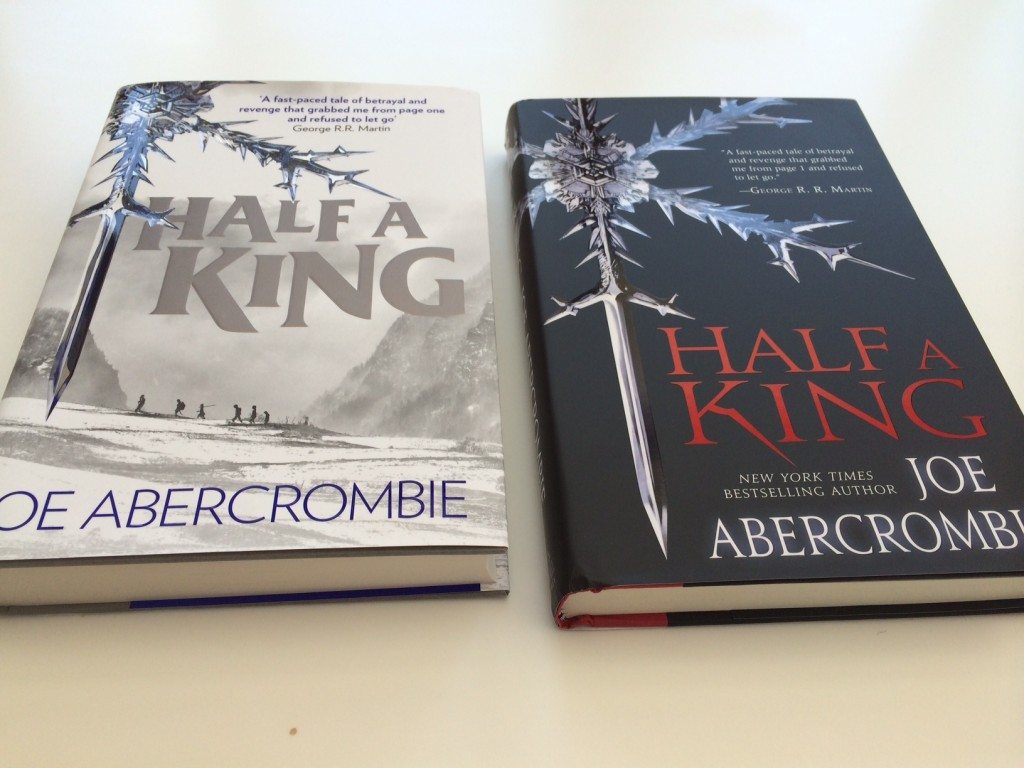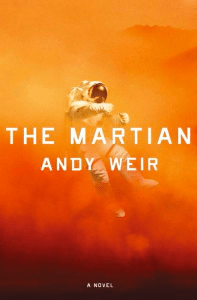“There’s more to life than books, you know. But not much more.” So says the little Emily Martin print I bought for my wife for Christmas, which we now have hanging right near the doorway to our dining room/library. Yep, my family adores books, and so do a lot of us GeekDad contributors. Here are some of our favorite reads from 2014.
(Disclaimer: We can’t claim to have read every book published last year, and sometimes we’re still reading books that were published even earlier, but these are our favorites that we actually read in the past year.)
Jonathan Liu’s picks:
Picture Books: My top picks for picture (or “picture”) books this year go to Poor Doreen: A Fishy Tale by Sally Lloyd-Jones & Alexandra Boiger and The Book With No Pictures by B.J. Novak. When it comes to books for kids, we love things that make us laugh, and these two were some of the most consistent (and persistent) at producing giggles. Poor Doreen was in my “Funny Pages” Stack Overflow column, and I interviewed B.J. Novak for the Bounded Enthusiasm podcast.
Kids’ books: This one was tough to narrow down, because there were several contenders, but I’ll narrow it down to two. I’ve read the first three books of The Chronicles of Kazam by Jasper Fforde aloud to my kids, and although some of the jokes fly over their heads, they’ve still enjoyed them and I’m eager to see where it goes next. Start with The Last Dragonslayer and enjoy the ride! And if you’ve got a kid who loves scary stories, Jonathan Auxier’s The Night Gardener is a deliciously creepy tale that’s wonderfully written. You can listen to my interview with Auxier for the Bounded Enthusiasm podcast.
Young Adult books: I didn’t read quite as many young adult books this year, partly because a lot of them are starting to feel the same to me. That’s why Grasshopper Jungle by Andrew Smith stood out: it’s a story that isn’t another carbon copy of a dystopian world, and I was truly surprised and entertained by the way things end up. Read my original review here.
Adult fiction: I read some great anthologies this year and a few novels, but my favorite this year was Tigerman by Nick Harkaway. I’ve been a fan since reading Angelmaker (and then going back to read The Gone-Away World) and his third novel did not disappoint. Harkaway managed to take his own fierce desire to be a father and inject it into a story about homemade superheroes, extralegal activities, and a doomed island. It’s a mash-up of literary fiction and science fiction and fantasy, but at the center is a very real emotional core.
Comics: This one’s tough. My kids picked Phoebe and Her Unicorn by Dana Simpson and El Deafo by Cece Bell, which they’ve both read so many times that I may need to buy new copies soon. (Actually, that is our second copy of El Deafo.) They’re both excellent choices–the first is good for laughs but is also pretty smart; the second is a smartly-written memoir but is also pretty funny. I’ll add to it This One Summer by Jillian Tamaki and Mariko Tamaki, a coming-of-age story for teens about two best friends and a summer of changes. And for the adults, you can’t go wrong with The Best American Comics 2014, edited by Scott McCloud and Bill Kartalopoulos. Bite-sized excerpts will soon add thirty-five more fantastic titles to your “to-read” list.
Nonfiction: I have to admit yet again that I didn’t read as many nonfiction books as I had hoped to, but most of my nonfiction reading doesn’t consist of books. I did, however, really enjoy Gwynne’s Grammar: The Ultimate Introduction to Grammar and the Writing of Good English by N.M. Gwynne. Some argue that grammar is simply defined by however people use words, and that there is no real “right” or “wrong” way to use language. Gwynne, however, know how silly that idea is, and goes about explaining how English should be used, with a good dose of humor and easy-to-understand examples.
Ethan Gilsdorf’s picks:
What If?: Serious Scientific Answers to Absurd Hypothetical Questions by Randall Munroe
Former NASA robot scientist Randall Munroe remade himself into an Internet hit with xkcd. The nerdy-quirky site features his cartoons and his popular feature “What If?,” which provides realistic answers to highly improbable questions — e.g. would happen if the entire earth’s population jumped up and down at the same time? Can you make a jetpack with enough AK-47s strapped to your back? These Q&As have been collected between book covers, and scattered with Munroe’s stick-figure cartoons. Boom! Instant bestseller. Reading What If? is more fun than watching a Mythbusters marathon, or blowing up your own planet.
American Cornball: A Laffopedic Guide to the Formerly Funny by Christopher Miller
As a kid, I watched Looney Tunes cartoons, Three Stooges reruns, and comic strips like Mutt and Jeff with all kinds of comic references to vacuum cleaner salesmen, hobos, mad scientists, get-rich-quick-schemes, and wives waiting at doorsteps with rolling pins to beat their drunk husbands. All humor from the 1930s, ’40s and ’50s had been trapped in a time machine that landed in the 1970s. Now comes American Cornball: A Laffopedic Guide to the Formerly Funny, a terrific book to explain the roots of the “things that used to make us laugh” that maybe we’re a little sheepish to find funny today.
The Geek’s Guide to Dating by Eric Smith
Eric Smith’s amusing manual helps clueless, single nerds gamify their fear of asking her (or him) out for Pan Galactic Gargle Blaster (AKA “drinks”). Cleverly divided into chapters and sections with tiles like “Do or Do Not, There Is No Try: Asking Her Out” and “If She Says No: How Epic Fails Make You a Better Player,” The Geek’s Guide to Dating explains the imaginary realm of girls in terms his audience can understand: caching ammunition, grinding your dating ability, and compiling your data on your quest to kissing that elf maiden goodnight. He equates getting ready for your romantic quest to equipping your D&D character for a deep dungeon crawl, and the guidance is appropriate for teens (and their parents) and is certainly not racy or explicit in any way. There’s fashion advice from Han Solo:”black jeans or pants, light long-sleeved shirt, dark vest.” There’s even Solo-like bon mots in case the mission isn’t accomplished: “Luckily, in life as in RPGs, you’ll always resurrect after a bad dating encounter.” Huzzah! [Note: This one came out in December of 2013, but I read it in 2014.]
The Art of Film Magic: 20 Years of Weta by Luke Hawker and Clare Burgess (with Brian Sibley; forward by Peter Jackson)
This is actually two hardcover books inside a fancy, heavyweight slipcase: Weta Workshop: Celebrating 20 Years of Creativity by Luke Hawker, and Weta Digital: 20 Years of Imagination on Screen, by Clare Burgess (with Brian Sibley). The two photo-laden books are hefty (as is the $100 price tag) but together they tell the comprehensive story of Weta, the now famous New Zealand special effects facility. Weta has two divisions: Weta Workshop, which handles physical effects like models, weapons, and prosthetics; and Weta Digtial, which creates computer generated effects. The books begin at the roots of Richard and Tania Taylor’s creature shop and early collaborations with Peter Jackson on Braindeadand Meet the Feebles, then continue with Weta’s formative work on Xena: Warrior Princess and Heavenly Creatures, and conclude with mature work on Lord of the Rings, Avatar, King Kong and The Hobbit, and other blockbusters (including The Avengers, Rise of the Planet of the Apes, Iron Man 3). The tomes also touch on Weta’s lesser known contributions to District 9, Master and Commander, Black Sheep, and various TV commercials and public art projects. Overall, Burgess and Sibley’s volume is the superior of the two, with stronger reporting and writing, with a great intro chapter on the history of special effects in the movies and details on how each effect is done; Weta Digital is also better designed and better looking. Hawker’s volume can feel awkwardly written, and strangely includes no direct quotes from the dozens of people he clearly spoke with; the layout of Weta Workshop is a bit wonky, too, with too small photos crammed into less attractive layout. Nonetheless, together, these two books are chock full with behind-the-scenes reveals that will delight special effects geeks.
Jenny Williams’ picks:
Letters of Note compiled by Shaun Usher
Page after page of meaningful, historical, whimsical, and poignant letters and correspondence make this non-fiction book a real page-turner. Based on the popular website of the same name, these letters will move you, each time you read them. These gathered letters cover the breadth and depth of human experience. From women who felt they needed to give up their babies, to Steve Martin’s sense of humor, to a postmaster in London during the Great Fire, to a letter from Mark Twain to Walt Whitman extolling the important parts of history that Whitman had witnessed in his life… The book contains so much that will provoke great thought and discussion.
The LEGO Neighborhood Book by Brian Lyles and Jason Lyles
A cross between an instruction manual and an idea book, this inspirational book will keep you busy for many hours as you learn to construct your own neighborhood made out of Lego. Use pieces you already have, or order some Pick a Brick pieces to round out your collection, and build apartment buildings, corner stores, street lights, cornices, benches, and other finishing touches. The book also contains ideas for building in other styles, and how to think about Lego as you create your own buildings from scratch. Create interior scenes to fill up the building insides, as well, and pose your minifigs just so.
Colonial Comics edited by Jason Rodriguez
Put together by a variety of authors and illustrators, this book isn’t a comprehensive history of the time. Rather, it tells individual stories of real people. Learn the story of the 7-year-old girl whose entire family was killed/kidnapped by French and Native Americans, who went on to grow up among those who kidnapped her. Learn about a schoolmaster in the Boston Latin School, the first public school in the United States. Learn about the first permanent Jewish settlement. Learn about the trial of Anne Hutchinson, a woman who dared to share her own interpretations of scripture. Comics and graphic novels are an extremely moving way to teach about history. Great comic artists can show the joy, anguish, discovery, and struggle that those who came before us experienced. For kids and adults who want to learn more about history but don’t want to slog through potentially dry textbooks and historical analyses, this book will allow them to do so with ease and enjoyment.
Neil Patrick Harris: Choose Your Own Autobiography by Neil Patrick Harris
You are Neil Patrick Harris as you choose your way through life, making decisions about your upbringing, personal life, acting career, and mad magic skills. Mixed in with actual anecdotes and events are alternate versions of your life as NPH. If you enjoy the entertainment and fabulousness that NPH brings to the table, you’ll love this autobiography. You’ll learn much about him as well, but it will probably be up to you to determine what is fact and what is fiction (though in most places it isn’t difficult to determine). Complete with some adorable (and sometimes awkward) photos, along with some input from his husband David, this book is a fun ride and you’ll come out the other side having walked a mile or two in NPH’s shoes.
Draw Paint Print Like the Great Artists by Marion Deuchars
Purposely teaching kids about different artists’ styles not only gives them practice in creating art, but in drawing from influences that speak to them. This fantastic art book will take your children through the art styles of famous artists such as Joan Miró, Gustav Klimt, Henri Matisse, Andy Warhol, and more, teaching about their methods, breaking them down into smaller steps. The book is aimed at kids aged 8-12, but I strongly recommend this book for anyone age 8 and up, including and especially grown-ups. Sometimes we forget how to create, forget how to play, forget how to experiment with new ideas.
The Art of Space by Ron Miller
The history of space art, from early imaginings of what is up there in the sky, to different ideas of how to find out, to realistic representations of actual events, is all included in this gorgeous coffee table space art book. In addition to its over 350 images, the book contains special features in each chapter profiling artists and particular topics, such as using space art as propaganda.
Brad Moon’s pick:
Area X: The Southern Reach Trilogy by Jeff VanderMeer
Jeff VanderMeer’s Southern Reach trilogy was one of the best things about 2014, especially if you’re a fan of suspense and the fantastically weird. Annihilation, Authority and Acceptance kept readers guessing and a little unsettled throughout the year and now all three books are available in single volume with Area X: The Southern Reach Trilogy. Read my original review here, or buy it from Amazon.
James Floyd Kelly’s pick:
Designers & Dragons by Shannon Applecline
If you are in any way interested in the history of role playing games, you’re going to love the Designers & Dragons four-volume set written by Shannon Applecline and published by Evil Hat. Available in print and digital versions, the sheer volume of games covered along with interviews, images, and secrets will make your head spin. With over 2000 pages of material and broken up by decade (’70s, ’80s, ’90s, and ’00s), this has got to be the most comprehensive project on RPGs that you’ll ever find. What began as a Kickstarter is now available to non-backers.
Designers & Dragons ’70s
Designers & Dragons ’80s
Designers & Dragons ’90s
Designers & Dragons ’00s
Michael Harrison’s pick:
Half a King by Joe Abercrombie
Joe Abercrombie is known for writing gritty, violent, Tarantino-esque fantasy literature. His First Law trilogy, as well as the other books set in the Circle of the World, explored vengeance, torture, madness, and power in a darkly humorous cinematic tone. When I found out that Abercrombie had released a young adult novel, I was… surprised? During a family road trip, we downloaded the audiobook (which is narrated by the exceptional John Keating), and I was ready to turn it off at a moment’s notice. The story of Yarvi, born with a crippled hand but forced into the impossible situation of ruling the harsh kingdom of Gettland, was fun, exciting, and every bit as no-nonsense gritty and cinematic as Abercrombie’s more mature offerings. Some of the scenes are bloody, and there’s a good bit of swordplay and death, but it’s perfect for young adult kids who are ready for some action and adventure. Buy it on Amazon.
Erik Wecks’ pick:
The Martian by Andy Weir
The Martian, which Jim Kelly described as “Mars Meets MacGyver” in his review, is far and away the best book of hard science fiction I’ve ever read. It’s the Robinson Crusoe of our time. From the opening line, the story of marooned astronaut Mark Watney’s struggle to survive four years alone on Mars grabs you and will not let go. This is an imaginary Apollo Thirteen writ large. Watney’s sarcasm and wry humor will keep you laughing even as he explains in an offhand way all the odds stacked against him and the science behind his choices. Weir’s greatest talent lies in his ability to make us forget we’re reading science fiction and pull us along in on a fantastic journey of survival and determination. Do not miss this book! It’s Fantastic! Buy it from Amazon.
